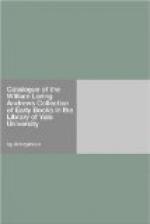In 1591 there was published at Bergamo an abridged Italian version, made from an illuminated Ms. which had once belonged to the famous library of Matthias Corvinus, but was then in the possession of Caterino Zeno, governor of Bergamo. It had been among the spoils carried to Constantinople after the capture of Buda by the Turks in 1526. There, seven years later, it had been bought and carried back to Italy by Caterino’s father, the younger Nicolo, who, in 1558, first gave to the world the narrative of his ancestors’ voyages. For no better reasons than that the Paduan Ms. also was illuminated in gold and colors, and that it had been bought twenty-five years before (c. 1700) in Venice where this branch of the Zeno family had become extinct, Muratori was inclined to identify it with the Corvinus Ms. The relations between Pius ii. and the king of Hungary, who was his ally in the proposed crusade against the Turks upon which he was just embarking when overtaken by death, and to whom the 48,000 ducats which he left behind him were sent in aid of the prosecution of war, suggest another possibility. It may be safely assumed that between the present Ms., given only an opportunity to acquire it, and any other copy the king’s choice could not have hesitated.
The Ms. is in 18th-century Italian binding, red morocco, gilt edges. Sold with other MSS. from the library of the Trivulzio family of Milan at Leavitt’s auction, New York City, November, 1886.
2. LIVIUS, Titus. Historiarum Romanarum libri I-X. Late 15th century.
Vellum. 336 leaves, the last blank. 34 quires all having ten leaves, except the 17th and 34th which have eight each. 31 lines to the page; catchword placed at right angles with the last line of the quire; ruled on both sides with plummet. Leaf 14-1/2 x 10 in., text-page 9 x 6 in.
Written in very regular, bold Italian minuscules of the period of the Renaissance.
The first page of the preface is surrounded by an illuminated border in gold and colors in the Renaissance style of ornament, into which are introduced the Caraccioli arms belonging to the distinguished Neapolitan family of that name. The initial F on this page is historiated with a view of Rome, and each of the ten books has an eight-line initial of dull gold on a background of red, blue and green, with marginal ornamentation.
From the close agreement, even in punctuation, between this Ms. and the edition printed at Milan in 1495 by Ulrich Scinzenzeler for Alexander Minutianus, and from other features which forbid the supposition that one is taken directly from the other, we must conclude that they both reproduce a common ancestor.




